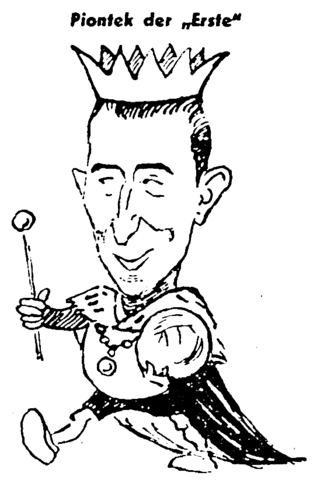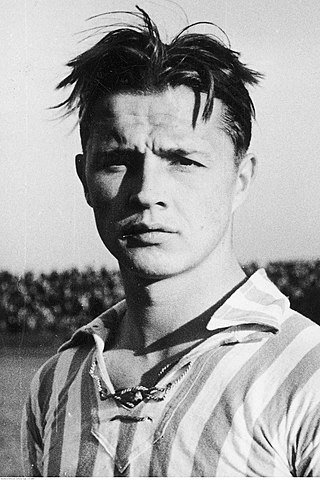
The 1938 FIFA World Cup was the third edition of the World Cup, the quadrennial international football championship for senior men's national teams and was held in France from 4 June until 19 June 1938. Italy defended its title in the final, beating Hungary 4–2. Italy's 1934 and 1938 teams hold the distinction of being the only men's national team to win the World Cup multiple times under the same coach, Vittorio Pozzo. It would be the last World Cup until 1950; the 1942 and 1946 World Cups were cancelled due to World War II.

Ruch Chorzów is a Polish association football club based in Chorzów, Upper Silesia. It is one of the most successful football teams in Poland, having won fourteen league titles, and the Polish Cup thrice. They currently compete in the Polish Ekstraklasa. Ruch's home venue is the Ruch Stadium, with a capacity of 9,300 seats. As it is currently under renovation, Ruch temporarily hosts their games at the Stadion Śląski with a capacity of 55,211 seats. The club is known for its Silesian identity. Ruch Chorzów has also had a very successful female handball team.

Leônidas da Silva was a Brazilian professional footballer who played as a forward. He is regarded as one of the most important players of the first half of the 20th century. Leônidas played for Brazil national team in the 1934 and 1938 World Cups, and was the top scorer of the latter tournament. He was known as the "Black Diamond" and the "Rubber Man" due to his agility.

Gérson de Oliveira Nunes, generally known as Gérson, is a Brazilian former association footballer who played as a midfielder. He won numerous national trophies with the club sides of Flamengo, Botafogo, São Paulo and Fluminense. He is widely known as being "the brain" behind the Brazil Football Team that won the 1970 FIFA World Cup in Mexico.
Krzysztof Ireneusz Warzycha is a Greek-Polish former professional footballer who played as a forward for Ruch Chorzów and for Greek club Panathinaikos. At international level, he played for the Poland national team, scoring nine goals in 50 appearances. He is widely considered as the best Panathinaikos player of all time.
The following are the association football (soccer) events of the year 1968 throughout the world.

Ernest Otton Wilimowski, nicknamed "Ezi", was a footballer who played as a forward. He ranks among the best goalscorers in the history of both the Poland national team and Polish club football. After re-taking German citizenship following the invasion of Poland, he also played for the Germany national team.

Gerard Wodarz was one of the best football players of interwar Poland. He was a multiple champion of the country and also played 28 games on the Poland national football team, scoring 9 goals.

Friedrich Egon (Fritz) Scherfke, was an ethnic German who became an interwar football midfield player for the Poland national football team. He is still one of the all time leading goalscorers of all time in the top Polish division with 131 goals.

Leonard Franciszek Piątek was a Polish footballer who played as a forward in the interwar period. In the spring of 1937 he changed his name to Leonard Franciszek Piątek.
Walter Henryk Brom was a Polish soccer goalkeeper. Brom, who played for Ruch Chorzów, was a reserve player of Polish team in FIFA World Cup 1938. He was the youngest goalie who has ever been listed in any World Cup finals. In early June 1938, when the tournament took place, he was only 17 years and 4 months old.
Jerzy Adolf Wostal was a Polish association football player, one of the best forwards of interwar Poland. He was born in 1914 in Königshütte.

The Last Game, as it is known in Poland, was played on Sunday, 27 August 1939, at the Stadion Wojska Polskiego in Warsaw. It was the last game of the interwar Polish football team before the Second World War. The Poland national football team faced and beat one of the best teams of that period – FIFA World Cup (1938) runners-up, Hungary, four goals to two. This match has generally been forgotten by the Hungarians – for them it was just one of many international friendlies, without any significance. In Poland, however, it is still remembered as the last match before World War II and also because it was a victory over a renowned team – the biggest success in history of Polish football up to that time.
Paweł Cyganek (1913–1995) was a soccer forward player of interwar Poland, who in one game played on the Poland national team. Cyganek was born in Wirek, a district of the Upper Silesian city of Ruda Śląska. From early childhood he loved soccer and was a very fast runner, so at age 14 he became a forward on the local team Wawel Wirek.

Teodor Peterek, was a Polish soccer player from the interwar period, forward, represented Ruch Chorzów and the Poland national team. He was born on 7 November 1910 in Schwientochlowitz, Germany, since 1920 Świętochłowice, and died on 12 January 1969 in Nowa Ruda.
The interwar period of Polish football began in the late fall of 1918 after First World War, when Poland regained independence, which had been lost at the end of 18th century (see: Partitions of Poland). The newly created country soon started to organize its administration and several national organizations. Among them was the PZPN – Polski Zwiazek Pilki Noznej, which was created on 20 and 21 December 1919 in Warsaw. According to some sources, several officials representing around 30 Polish Football clubs were then present in Warsaw, but the list of them has been lost.
Romeu Pellicciari, also known as Romeu was an association footballer in striker role.
Poland Ekstraklasa, meaning "Extra Class" in Polish, named PKO Bank Polski Ekstraklasa since the 2019–20 season due to its sponsorship by PKO Bank Polski, is the top Polish professional league for men's association football teams.

Waldyr Pereira, also known as Didi, was a Brazilian footballer who played as a midfielder or as a forward. He played in three FIFA World Cups, winning the latter two.











